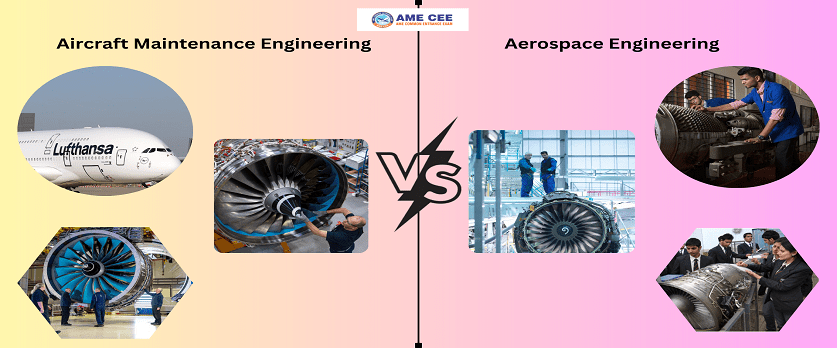The choice between Aircraft Maintenance Engineering (AME) and Aerospace Engineering ultimately depends on individual interests, career goals, and preferred areas of specialization. Both fields offer unique opportunities and challenges, and what may be “best” for one person might not be the same for another. Let’s explore the key aspects of each field to help you make an informed decision based on your priorities:
Interest and Passion
AME
Ideal for individuals passionate about hands-on work and ensuring the safety and airworthiness of aircraft. If you enjoy practical problem-solving and working with aircraft systems, AME might be a perfect fit.
Aerospace Engineering
Suited for those fascinated by the design, development, and innovation of aircraft and spacecraft. If you are drawn to research, technology, and pushing the boundaries of aerospace technology, Aerospace Engineering could be your calling.
Scope and Specialization
AME
Focuses on aircraft maintenance, repair, and inspection. Specializations may include mechanical or avionics.
Aerospace Engineering
Covers a broad spectrum, including aircraft design, propulsion systems, avionics, and space exploration. It offers opportunities for specialization in various cutting-edge fields.
Program Duration and Education
AME
Programs are often shorter, typically around 2-3 years, allowing for quicker entry into the workforce.
Aerospace Engineering
Involves a longer duration, usually a four-year bachelor’s degree, providing a comprehensive education in aerospace principles.
Job Roles and Responsibilities
AME
Involves hands-on work in aircraft maintenance, inspecting, troubleshooting, and repairing various components. AME professionals ensure compliance with safety regulations.
Aerospace Engineering
Offers diverse roles, including design, research, and development. Aerospace engineers work on creating new technologies, improving existing systems, and contributing to advancements in aerospace.
Job Security and Demand
AME
Job security is generally robust due to the continuous need for aircraft maintenance. The aviation industry’s growth contributes to sustained demand for skilled AME professionals.
Aerospace Engineering
Job security is stable, driven by advancements in aviation and space exploration. Engineers with expertise in emerging technologies are often in high demand.
Salary Potential
AME
Competitive salaries, especially with experience and specialization. Working for major airlines, maintenance organizations, or regulatory bodies can offer lucrative opportunities.
Aerospace Engineering
Offers competitive salaries, particularly in leading aerospace companies, research institutions, or government agencies.
Conclusion
The “best” choice between AME and Aerospace Engineering depends on your personal preferences and career objectives. If you enjoy hands-on work and ensuring the safety of aircraft, AME may be the right fit. If you’re passionate about technology, design, and contributing to the future of aerospace, Aerospace Engineering might be more aligned with your goals. Consider your interests, desired level of education, and the specific roles each field offers to make an informed decision that aligns with your aspirations.
Frequently Asked Questions (FAQs) that can help individuals navigate the decision between Aircraft Maintenance Engineering (AME) and Aerospace Engineering
Q1. What is the primary difference between AME and Aerospace Engineering?
Answer: AME focuses on aircraft maintenance, repair, and inspection, ensuring their airworthiness. Aerospace Engineering involves designing, developing, and innovating aircraft and spacecraft technologies.
Q2. Which field offers a broader scope in terms of career opportunities?
Answer: Aerospace Engineering generally provides a broader scope due to its diverse specializations, including aircraft design, propulsion, avionics, and space exploration.
Q3. How long does it take to complete the education in AME and Aerospace Engineering?
Answer: AME programs are typically shorter, around 2-3 years, while Aerospace Engineering involves a four-year bachelor’s degree. The duration can influence the time it takes to enter the workforce.
Q4. What are the primary responsibilities of professionals in AME and Aerospace Engineering?
Answer: AME professionals focus on hands-on maintenance, inspection, and repair of aircraft components. Aerospace engineers are involved in designing, researching, and developing aircraft and spacecraft technologies.
Q5. Are there specific specializations within AME and Aerospace Engineering?
Answer: Yes, AME professionals can specialize in areas such as mechanical or avionics. Aerospace Engineering offers diverse specializations, including aeronautics, astronautics, propulsion systems, and avionics.
Q6. What is the job market and demand like for AME and Aerospace Engineering professionals?
Answer: AME professionals have consistent demand due to the ongoing need for aircraft maintenance. Aerospace engineers are in demand, especially with advancements in technology and the growth of the aviation and space industries.
Q7. How do salaries compare between AME and Aerospace Engineering?
Answer: Both fields offer competitive salaries. AME professionals can earn well, especially with experience and specialization. Aerospace engineers working for leading companies or in research roles also command competitive salaries.
To become an aircraft maintenance engineer you may could join AME engineering through AME COMMON ENTRANCE EXAM (AME CEE) this examination you may join AME engineering approved by DGCA, EASA or UGC.


